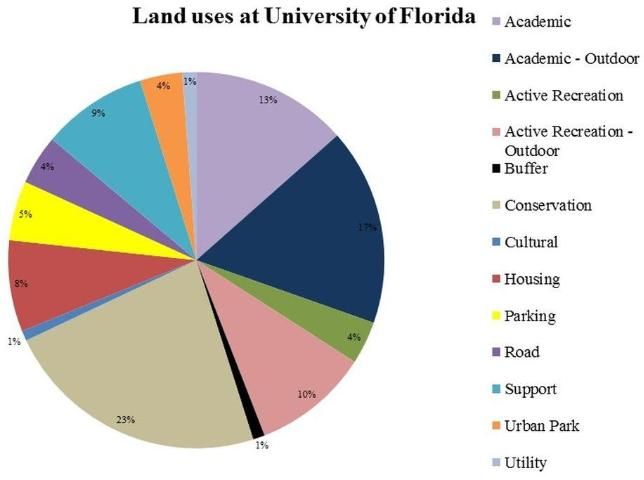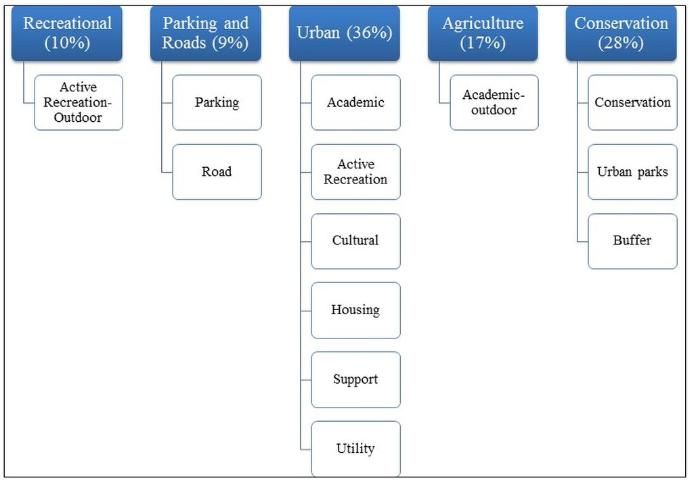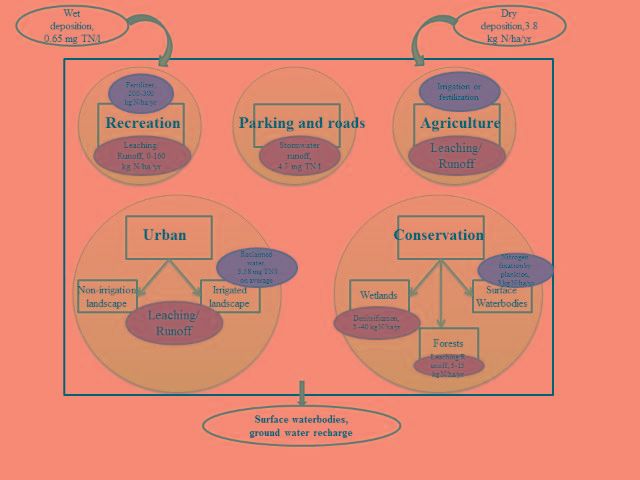Basics of Quantifying N Sources and Fates on the University of Florida Campus
Introduction
Nitrogen (N) is an essential plant nutrient in urban environments for the growth of landscape plants such as turfgrass and ornamental plants. An important source of N in the urban environment is fertilizer. Landscapes, recreational areas, and sports fields are important parts of the University of Florida campus that receive N fertilization to maintain the health and quality of their plants. However, nitrogen can be lost from the landscape through runoff in storm water or by leaching into groundwater, both fates leading to pollution of the receiving water bodies. Human activities can also cause losses of N. Therefore, educating people about N cycling in the urban environment is critical for developing solutions to the environmental problems caused by loss of N.
In recent years, increasing attention has been paid to nutrient cycling in urban ecosystems of US cities (Grossmann 1993). The most influential long-term urban ecological studies in the United States are being conducted in Phoenix and Baltimore in association with the US Long-Term Ecological Research (LTER) network. For example, Baker et al. (2001) developed a comprehensive nitrogen (N) balance model for the city of Phoenix. Their model accounted for N in a series of subsystems such as cropland, wastewater, desert, atmosphere, landscape, and subsurface areas. The authors concluded that commercial fertilizer and N fixation from the combustion of automobile engines were the major sources of N and that volatilization and gaseous-N transport from combustion and denitrification were the main output pathways, if the atmospheric subsystem was taken into consideration (Baker et al. 2001).
Urban sustainability initiatives have become popular worldwide, including initiatives on college and university campuses. For example, 1,262 campus assessments of sustainability issues had been completed at institutions worldwide by 2005 (Savanick et al. 2007). At least 665 colleges and universities have already signed the American College and University Presidents' Climate Commitment. Specific journals such as International Journal of Sustainability in Higher Education, which focuses on the sustainability activities and sustainable development in higher education, were established in recent years to summarize sustainability work on campuses. However, only a few urban ecosystem studies on nutrients associated with college and university campuses have been done (Savanick et al. 2007). There are similarities between a major university and a major city with respect to the urban N mass balance. Similar approaches from peer-reviewed urban mass balance literature were used to describe N cycling on the University of Florida campus. The goal of this publication is to help land-use decision-makers, county UF/IFAS Extension agents, and students better understand N inputs and outputs and cycling in an urban environment by using the campus as an example.
Terms
Wet deposition of N: Nitrogen that falls to the ground associated with rain, fog, and snow.
Dry deposition of N: Nitrogen that falls to the ground with gases and particles.
Denitrification: A bacteria-mediated process under anaerobic conditions that reduces nitrogen oxides (such as nitrate) to nitrogen gas. This is a pathway for nitrogen to be lost from nitrate fertilizer.
Anthropogenic N: Nitrogen in the ecosystem that results from human activities, such as fertilization, gas emission from cars, or wastes.
N fixation: A process where molecular nitrogen (N2) from the air is converted to ammonia and then to organic nitrogen (in plant roots). N fixation can be done biologically in certain plants (Rhizobium bacteria associated with roots of legumes) or chemically by the Haber-Bosch process (N fertilizer), lightning, or fossil fuel combustion (e.g., automobiles).
What Is a Nitrogen Mass Budget?
Nitrogen is an important nutrient in ecosystems with plants and animals because it is required for plant and animal growth. In excessive amounts and under improper management, however, N can lead to degradation of water quality.
A nutrient budget is the quantification of nutrient inputs and outputs for a defined ecosystem, so a nitrogen mass budget can determine where N is being added and lost and where to focus on improving N management practices for reducing N losses. The approach of estimating elemental budgets is widely applied in the world by researchers who study human impacts on the environment (de Vries et al. 2011; Pathak et al. 2010). For example, the global budget for chloride was determined to illustrate how the small amounts of chlorofluorocarbons released by humans are the source of nearly all the chlorine (Cl) that mixes in the stratosphere (Graedel and Keene 1996), where it degrades ozone (Rowland and Molina 1975). A closed budget is defined by Nixon et al. (1995) as one in which all of the inputs to and all of the outputs from a system are measured independently over the same period of time and found to balance. Alternatively, a budget may be positive (documenting a buildup of nutrients) or negative (showing a loss of nutrients).
Land Uses in a Major University
Developing an N mass budget requires knowledge of the land uses in the ecosystem of interest. Groffman et al. (2004) applied the watershed approach to estimate the N input–output budget in six different watersheds, each having one dominant land use. These workers found that urban and suburban watersheds had much higher N losses than the completely forested watershed but lower N losses than the agricultural watershed (Groffman et al. 2004). Retention of N in the suburban watershed was highly dominated by fertilizer and atmospheric N deposition. Like a major city, a major university functions as an entity that involves the interrelationships between people and the natural and built-up environments. Further, a major university has a similar structure as a major city in terms of land uses, so a similar approach can be used to develop an N mass budget for either one.
A summary of the land use pattern of the University of Florida campus is shown in Figure 1. Like a major city, the campus contains residential (housing), commercial/office (academic), parking and transportation (roads), and open space (conservation areas and parks). The difference might be that a major university like the University of Florida has a large portion of recreational land use and sports fields, which are likely to involve intensive irrigation and fertilization.

Credit: Physical Plant Division of University of Florida
Land uses in Figure 1 are recategorized based on the function and structure of the land use on the University of Florida campus and are summarized in Figure 2 with the percentage of land use on the campus.

Credit: Jiexuan Luo, UF/IFAS
Sources and Fates of Nitrogen Associated with Different Land Uses on Campus
Figure 3 summarizes the sources and fates of N associated with various land uses likely to be present on a university campus. The amounts of N shown in Figure 3 were derived from the literature with references listed in Table 1. Most of the cited research was conducted in Florida areas that have similar characteristics to the University of Florida campus in geology, climate, and land use. For example, the wet deposition data and stormwater N runoff data were retrieved from Zhang and Sansalone's research (2014) conducted in a parking lot at University of Florida campus. The dry deposition data were obtained from one of the stations from Clean Air Status and Trends Network (CASTNet) in Indian River Lagoon, Florida. The denitrification data were summarized from the research conducted in Lake Okeechobee, which is a large, shallow lake in Florida with moderate eutrophication.

Credit: Jiexuan Luo, UF/IFAS
These values are presented to provide estimates of N pools on a campus to illustrate a potential budget for the University of Florida campus. Combustion N is excluded because it is unlikely to differ among land uses in such small areas and because there are insufficient data to make estimates. In addition, the N losses from manured and pasture lands are omitted in the agriculture land use because the animals do not live on the main campus. An understanding of the sources and fates of N can help determine which land uses may present the greatest threat for N losses to water bodies. This understanding of sources and fates of N can also help to determine the appropriate best management practices to reduce N losses and perhaps fertilizer costs.
In terms of nitrogen inputs, fertilizer constitutes a large input to a university campus. Fertilizer is used to maintain the functional and aesthetic appeal of turfgrass in recreational and athletic areas. Leaching of N from turfgrass can range from near zero to more than 100 kg/ha, usually related to rates and timing of N fertilizer and irrigation management (Nixon et al. 1995). Wet deposition and dry deposition occur everywhere on campus regardless of the land use type. Additional anthropogenic N inputs are nutrients supplied with the irrigation well water and the reclaimed water used for irrigation. Even though agricultural land use may cover a relatively large portion of campus area, it is used for the agricultural experimentation and teaching purposes at University of Florida. Records of fertilizer use typically are not available, and it is likely that these areas have relatively small amounts of anthropogenic N input. Impervious surfaces such as parking lots generate a very high total nitrogen load, mostly from organic matter and automobile exhaust (Carey et al. 2013). Together with the large volume of runoff, the total N mass can be significant.
In terms of the nitrogen outputs, leaching can be an important loss pathway. The N lost by leaching to groundwater or surface water bodies can lead to pollution of those waters. The process of denitrification in wetland and surface water bodies plays a profound role in N loss. Denitrification can play a positive role in preventing water pollution by converting nitrate-N to gaseous N, which is lost to the atmosphere before it can reach the groundwater, lake, or river.
Conclusion
The N pathways in a major university are similar to those in a major city due to similarities in land use structure and N pollutant sources. In this publication, we draw on the research literature for urban nutrient budgeting to illustrate how a potential nitrogen budget for the University of Florida campus could be developed.
A nitrogen budget can quantify the N associated with the various land uses on campus and point to the most important sources of N. For example, recreational areas involving irrigation and fertilization may be the most important sources of N on campus. From a practical point of view, strategies that can improve the fertilization rates and reduce leaching or runoff in the recreational land uses can also help reduce the nutrient loads and promote environmental sustainability. The largest sources of N to an ecosystem should be the sources receiving the most attention for careful management. Once the major potential outputs are identified, the nutrient manager can focus on best management practices that minimize the losses of nutrients.
References
Baker, L. A., D. Hope, Y. Xu, J. Edmonds, and L. Lauver. 2001. "Nitrogen balance for the Central Arizona–Phoenix (CAP) ecosystem." Ecosystems 4: 582–602.
Barton, L., and T. D. Colmer. 2006. "Irrigation and fertiliser strategies for minimising nitrogen leaching from turfgrass." Agricultural Water Management 80: 160–175. DOI: http://dx.doi.org/10.1016/j.agwat.2005.07.011.
Brezonik, P. L. 1972. "Nitrogen: sources and transformations in natural waters." In Nutrients in Natural Waters, edited by H. E. Allen and J. R. Kramer. New York: John Wiley & Sons, 1–50.
Carey, R. O., G. J. Hochmuth, C. J. Martinez, T. H. Boyer, M. D. Dukes, G. S. Toor, and J. L. Cisar. 2013. "Evaluating nutrient impacts in urban watersheds: Challenges and research opportunities." Environmental Pollution 173: 138–149.
de Vries, W., A. Leip, G. Reinds, J. Kros, J. P. Lesschen, and A. Bouwman. 2011. "Comparison of land nitrogen budgets for European agriculture by various modeling approaches." Environmental Pollution 159: 3254–3268.
Fenn, M. E., M. A. Poth, J. D. Aber, J. S. Baron, B. T. Bormann, D. W. Johnson, A. D. Lemly, S. G. McNulty, D. F. Ryan, and R. Stottlemyer. 1998. "Nitrogen excess in North American ecosystems: Predisposing factors, ecosystem responses, and management strategies." Ecological Applications 8: 706–733.
Graedel, T. E., and W. Keene. 1996. "The budget and cycle of Earth's natural chlorine." Pure and Applied Chemistry 68: 1689–1697.
Groffman, P. M., N. L. Law, K. T. Belt, L. E. Band, and G. T. Fisher. 2004. "Nitrogen fluxes and retention in urban watershed ecosystems." Ecosystems 7: 393–403.
Grossmann, W. D. 1993. "Integration of social and ecological factors: Dynamic area models of subtle human influences on ecosystems." In Humans as Components of Ecosystems, edited by M. J. McDonnell et al. New York: Springer-Verlag. 229–245.
Hanson, G. C., P. M. Groffman, and A. J. Gold. 1994. "Denitrification in riparian wetlands receiving high and low groundwater nitrate inputs." Journal of Environmental Quality 23: 917–922.
Messer, J., and P. L. Brezonik. 1983. "Comparison of denitrification rate estimation techniques in a large, shallow lake." Water Research 17: 631–640.
Miller, G. L., and J. L. Cisar. 1990. Maintaining Athletic Fields. Gainesville: University of Florida Institute of Food and Agricultural Sciences. Bulletin 262.
Nixon, S., S. Granger, and B. Nowicki. 1995. "An assessment of the annual mass balance of carbon, nitrogen, and phosphorus in Narragansett Bay." Biogeochemistry 31: 15–61.
Pathak, H., S. Mohanty, N. Jain, and A. Bhatia. 2010. "Nitrogen, phosphorus, and potassium budgets in Indian agriculture." Nutrient Cycling in Agroecosystems 86: 287–299.
Rowland, F. S., and M. J. Molina. 1975. "Chlorofluoromethanes in the environment." Reviews of Geophysics 13: 1–35. DOI: 10.1029/RG013i001p00001.
Savanick, S., L. Baker, and J. Perry. 2007. "Case study for evaluating campus sustainability: Nitrogen balance for the University of Minnesota." Urban Ecosystems 10: 119–137.
Zhang, H. and J. Sansalone. 2014. "Partitioning and first-flush of nitrogen in rainfall-runoff from an urban source area." J. Environ. Eng., 10.1061/(ASCE)EE.1943-7870.0000832, 04014027.


